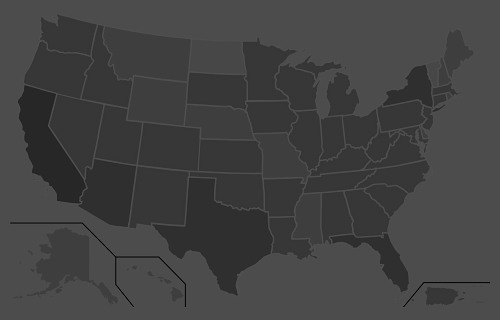“Our added winter moisture and active calling period led to a very long nesting and hatching season, starting in late April and extending into early summer, with chicks hatching as late as early July,” O’Dell said. “From a population standpoint, we are out of a deficit for the first time since 2001-2002. Quail are starting to pop up in places they haven’t been seen in a while.
“If you’ve never had the chance to experience what Arizona quail hunting built its name on, then this would be the year to get out and enjoy it.”
Meanwhile, hunters should note that the season for Mearns’ quail doesn’t begin until Dec. 4. It’s summer rainfall that plays a key role in nesting success and population numbers of this species. After a spotty and relatively weak monsoon across southern Arizona, these birds are likely to be abundant only in pockets that received sufficient precipitation this summer.
A valid Arizona hunting or combination hunt and fish license is required for all hunters 10 and older. Those hunters under 10 must either have a valid hunting or combination hunt and fish license, or be accompanied by an adult who possesses a valid hunting or combination hunt and fish license. Licenses can be purchased online or at license dealers statewide. A youth combination hunt and fish license (ages 10 to 17) is $5.
The general bag limit is 15 quail per day in the aggregate, of which no more than eight may be Mearns’ quail (when the Mearns’ season opens Dec. 4). The general possession limit is 45 quail in the aggregate after opening day, of which no more than 15 Gambel’s, scaled or California quail in the aggregate may be taken in any one day. After the opening of the Mearns’ season, the 45-quail possession limit may include 24 Mearns’ quail, of which no more than eight may be taken in any one day.
More quail-hunting information can be found on the department’s website at https://www.azgfd.com/Hunting/. Another resource for both new and experienced hunters alike is “An Introduction to Hunting Arizona’s Small Game.” Written by Randall D. Babb, the 196-page, full-color book covers where and how to hunt small game birds (like quail), squirrels, rabbits, ducks and geese. It also includes how to prepare and cook your harvest, with illustrations and recipes. The book can be ordered for $16.95 at www.azgfd.gov/publications.
Finally, hunters should check out O’Dell’s techniques for field-dressing quail at https://www.youtube.com/watch?v=3gRwZAcWzzk.
####
Publishers Notes: OUT OF STATE HUNTERS, FISHERMEN & OUTDOOR ENTHUSIASTS; Due to the Covid 19 pandemic, there could be limitations for OUT of STATE hunters, fishermen and other outdoor enthusiasts to include a 14-day quarantine requirement or negative COVID-19 testing alternative. Please check with the State's Department of Natural Resources BEFORE you travel or apply for the 2020 Fall Hunts.
Disclaimer: The views expressed on this site are that of the authors and not necessarily that of TBC Press
Maryland Midwinter Waterfowl Survey 2022 Results
Submitted by: TBC Press
Posted on: 03/01/22
The Backcountry Press
The country's premier daily HUNTING, FISHING & OUTDOOR news in the USA and around the globe. Read whats happening in your neck of the woods & beyond.
© 2020 TBC Press - All Rights Reserved Website Design by:
News # 14732
Hunter reports suggest that late arriving winter weather moved more scaup, canvasbacks, and redheads into the Chesapeake Bay region after the survey was completed. Biologists counted more Canada geese – 361,100 – than the 2020 survey, which counted 327,200. DNR considers this a hopeful sign that flyway wide harvest restrictions for Atlantic Population (AP) geese are working.
The Midwinter Waterfowl Survey has been conducted annually since the early 1960s, and covers most of the tidal shorelines and near-shore waterfowl habitat in Maryland. These numbers are not population estimates, but offer an annual “snapshot” view of how waterfowl use of important nearshore habitats changes over time.
Licenses, stamps, and permits may be purchased online by phone at 855-855-3906, at a Natural Resources Service Center or at any one of the more than 250 Sport License Agents statewide.
Hunters with questions may contact the Maryland DNR Wildlife and Heritage Service at 410-260-8540.
For indepth information on the Survey Results see; Midwinter Waterfowl Survey Results 2017-2022
####
In early January, aerial survey teams of pilots and biologists from the Maryland Department of Natural Resources (DNR) made visual estimates of the ducks, geese and swans along most of the state’s Chesapeake Bay, Potomac River. and Atlantic Ocean coastal shorelines. This year, the teams counted about 563,800 waterfowl, lower than the 627,000 birds observed in 2020, and below the most recent five-year average of 718,600 birds. The 2021 Mid-Winter Survey was not flown due to the COVID-19 pandemic.
“Winter distribution of waterfowl is influenced by many factors,” Maryland DNR Wildlife and Heritage Director Paul Peditto said. “Global weather patterns, food availability, habitat quality, prevalence of ice, and the population status of each species all play a role in how many birds we count and where we count them.”
Overall, dabbling ducks increased in number this year compared to 2020, as did pintails and green-winged teal, which likely reflected the mild fall temperatures. Likewise, generally mild winter weather likely led to fewer diving ducks being observed than in the 2020 survey.












